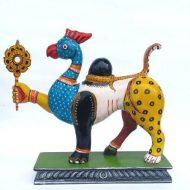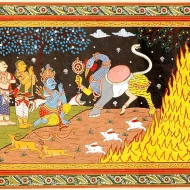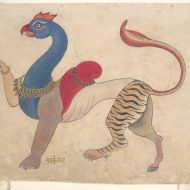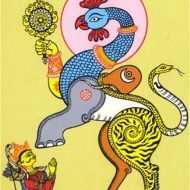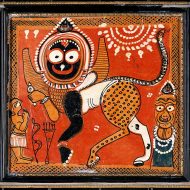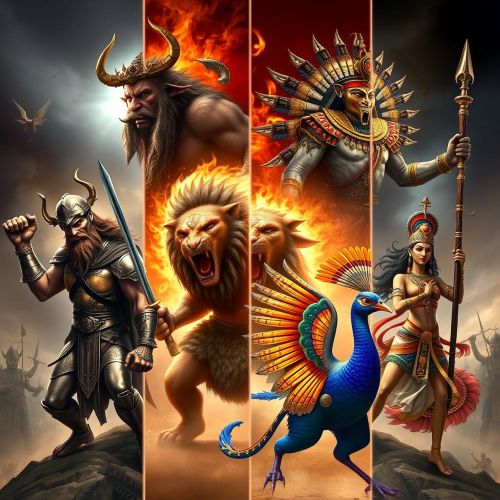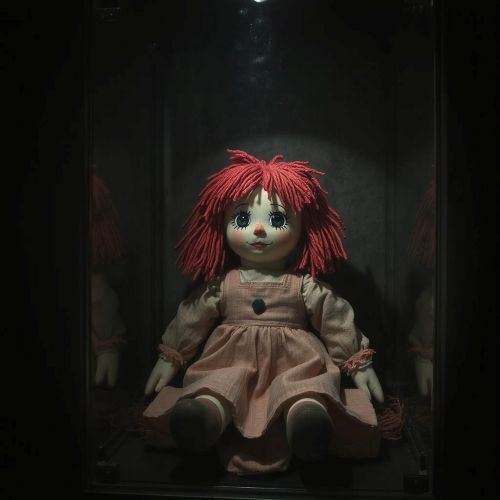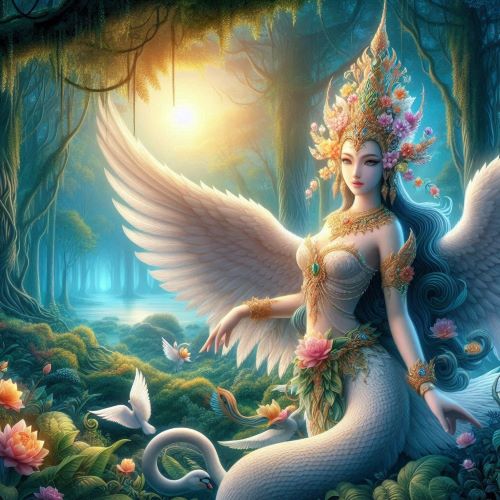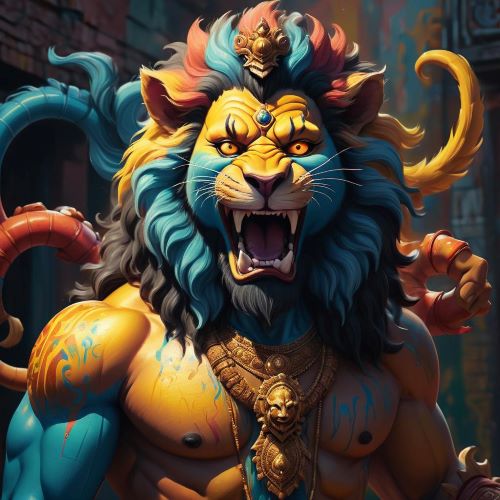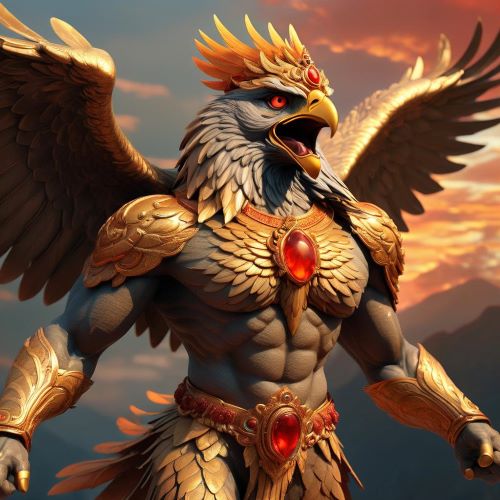Navagunjara : The Ultimate Hybrid
Listen
At a glance
| Description | |
|---|---|
| Origin | Indian Mythology |
| Classification | Hybrids |
| Family Members | N/A |
| Region | India |
| Associated With | Orissa, Jaganath Puri Temple |
Navagunjara
Introduction
The Navagunjara is a mythical creature composed of nine forms. It is a popular motif in Odiya folk art and literature. It finds mention in the Odiya Mahabharata written by Sarla Das. The motif is said to have originated from the legend of the Jagannath temple in Puri. According to legends, the prince from Hastinapur, who was known as Arjuna, first saw it.
Physical Traits
Navagunjara, a fascinating and enigmatic entity, exhibits a captivating fusion of various animal attributes. Its head resembles that of a rooster, while its feet are a blend of an elephant, tiger, and deer or horse, with a raised human arm carrying a lotus or a wheel as its fourth limb. The creature boasts the neck of a peacock, the back or hump of a bull, and the waist of a lion, complemented by a serpent tail.
Family
When Arjuna first encounters Navagunjara, he experiences a mix of terror and fascination, unsure of how to respond to such an extraordinary sight. His instinctive reaction is to raise his bow, ready to shoot the mysterious being. However, as he gazes upon Navagunjara more closely, he gradually comprehends the divine presence it embodies. Realizing that Navagunjara is, in fact, a manifestation of the revered deity Vishnu, Arjuna’s fear subsides, and he humbly bows before the magnificent creature, choosing to drop his weapons in a show of respect and reverence.
Other names
Its is also known as the Nabagunjara in some areas of Orissa.
Powers and Abilities
Subsequently, Krishna reveals himself to Arjuna, explaining that the Navagunjara is yet another manifestation akin to the Viratsvarupa, as described in the Bhagavad Gita. Through the Navagunjara, Krishna illustrates the diverse ways individuals perceive and interpret reality. Though the ultimate reality remains singular, it manifests differently to each person based on their individual perspective and inherent nature, their svabhava.
In essence, the message conveyed by Krishna to Arjuna is that the Hindu tradition embraces multiplicity, and the different approaches to perceiving and comprehending reality are all valid and enriching. Rather than seeking uniformity, the Hindu ethos encourages a celebration of diverse perspectives and an appreciation of the vast tapestry of human experiences on the journey towards ultimate truth.
Modern Day Influence
It is fascinating to observe the contrasting perspectives on divine beings in different cultural narratives. In the context of the Puri Jagannath temple, a unique entity composed of nine different species is revered as divine rather than being labeled as a monster, unlike the creatures in Greek stories such as Hydra and Chimera. The Greek narratives often portray these multi-headed and composite creatures as immoral and monstrous, warranting their destruction by heroic figures like Bellerophon and Hercules.
These two divergent worldviews showcase the varied ways in which cultures perceive and relate to the concept of divinity. While Greek mythology emphasizes the triumph of order over chaos through heroic actions, Hindu philosophy, as illustrated in the Bhagavad Gita, advocates for a deeper understanding of the divine nature inherent in all forms of life, encouraging harmony and compassion.
The dichotomy between these two perspectives offers a glimpse into the complexities of human beliefs and the ways in which different cultures grapple with the idea of divinity. Both worldviews, with their distinct approaches, have shaped the spiritual and philosophical landscapes of their respective civilizations, leaving a profound impact on the understanding of the divine and its connection to the world around us.
Related Images
Frequently Asked Questions
What is lorem Ipsum?
I am text block. Click edit button to change this text. Lorem ipsum dolor sit amet, consectetur adipiscing elit. Ut elit tellus, luctus nec ullamcorper mattis, pulvinar dapibus leo.
What is lorem Ipsum?
I am text block. Click edit button to change this text. Lorem ipsum dolor sit amet, consectetur adipiscing elit. Ut elit tellus, luctus nec ullamcorper mattis, pulvinar dapibus leo.
What is lorem Ipsum?
I am text block. Click edit button to change this text. Lorem ipsum dolor sit amet, consectetur adipiscing elit. Ut elit tellus, luctus nec ullamcorper mattis, pulvinar dapibus leo.
What is lorem Ipsum?
I am text block. Click edit button to change this text. Lorem ipsum dolor sit amet, consectetur adipiscing elit. Ut elit tellus, luctus nec ullamcorper mattis, pulvinar dapibus leo.
What is lorem Ipsum?
I am text block. Click edit button to change this text. Lorem ipsum dolor sit amet, consectetur adipiscing elit. Ut elit tellus, luctus nec ullamcorper mattis, pulvinar dapibus leo.

